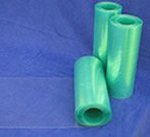The eyes of moths are providing inspiration for the next generation of solar panels.
Moths are able to see well at night and their eyes have a water-repellent, antireflective coating – one of the least reflective surfaces in nature.
According to a release from the Optical Society, a team of researchers in Japan have created a new film that mimics these qualities for use with solar cells to improve their efficiency by reducing reflection of the sun’s rays and allowing more solar power to be harvested.
The researchers estimate the green-tinged film would improve the efficiency of solar cells by 6 percent in Phoenix and by 5 percent in Tokyo. Phoenix, Arizona is considered a “sunbelt” city, whereas solar resources in Tokyo, Japan aren’t as plentiful.
While this improvement may seem small, research leader Noboru Yamada, a scientist at Nagaoka University of Technology Japan, points out that every little bit helps.
Yamada and his colleagues discovered the moth’s characteristics a few years ago when they began looking for a broad-wavelength and omnidirectional antireflective structure in nature. The team is now working on enhancing the durability of the film and optimizing it for various types of solar cells.
Yamada’s team aren’t the first to realise the potential of moth-eye bio-mimicry. Autoflex MARAG (motheye antireflective, antiglare) was developed jointly by Autotype and the Fraunhofer Institute for Solar Energy in Germany in 2003.
The further pursuit of the moth-eye film shows, once again, nature holds many of the keys to the biggest challenges facing humanity – including how we harvest energy and further refine those processes. As King Solomon is reported to have said – there is nothing new under the sun.












































